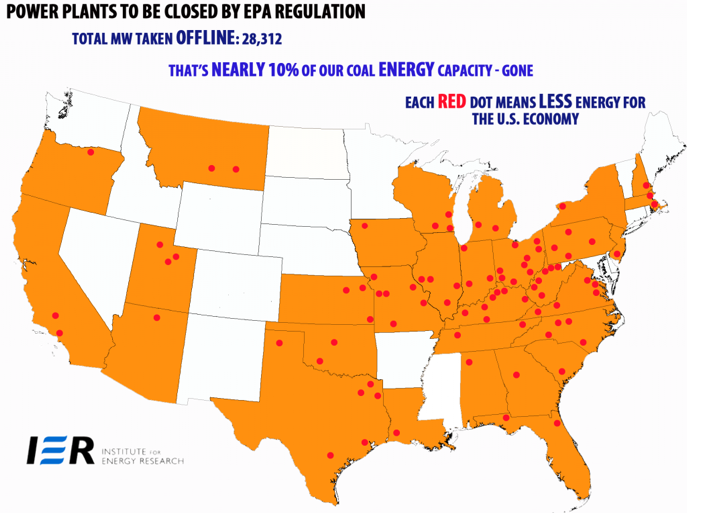As a result of EPA’s Destructive Regulations“These rules will make electricity more expensive and less reliable.They will cost thousands of workers their jobs, and require consumers to pay more for electricity. At least, they will fulfill the President’s campaign pledge to make the cost of electricity ‘necessarily skyrocket’.
WASHINGTON – Today, the Institute for Energy Research issues a report (which can be found here) listing the powerplants likely to be closed as a result of the U.S. Environmental Protection Agency’s regulations commonly known as the Utility MACT and the Cross State Air Pollution Rule.
IER President Thomas Pyle said, “These rules will make electricity more expensive and less reliable. They will cost thousands of workers their jobs, require millions of consumers to pay more for electricity, and mean billions of dollars will have to be spent to build replacement power. At least they will fulfill the President’s campaign pledge to make the cost of electricity ‘necessarily skyrocket’.
According to the report, which used EPA’s own modeling, as well as company announcements, to construct a list of coal-fired powerplants likely to retire, EPA regulations will result in the closing of at least 28 gigawatts (GW) of generating capacity (which is the equivalent of closing every powerplant in the state of North Carolina or Indiana).
The 28 gigawatts in closings are about twice as much as the 14.5 gigawatts EPA had originally predicted would close as a result of the rules. It is also more than the worst case scenarios had projected — analysis by the North American Electric Reliability Corporation (NERC) anticipated that CSAPR and the Utility MACT would close 20 GW of generating capacity.
For purposes of comparison, 28 gigawatts is about 2.5% of the total U.S. generating capacity, and represents about 30 times the installed capacity of all solar utility generation in the U.S.
Finally, our work indicates that these EPA regulations will have a dramatic impact on states reeling from economic hardship. For example:
• Ohio: 2,894 MW retired, 8.6% of state total generating capacity.
• West Virginia: 2,448 MW retired, 14% of state total generating capacity.
• Indiana: 2,168 MW retired, 7.5% of state total generating capacity.
• Tennessee: 1,376 MW retired, 6.2% of state total generating capacity.
• Missouri: 1,325 MW retired, 6.3% of state total generating capacity.
• Wisconsin: 902 MW retired, 5% of state total generating capacity.




